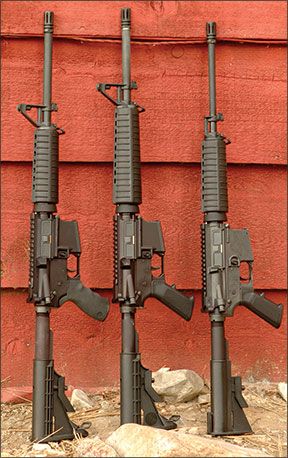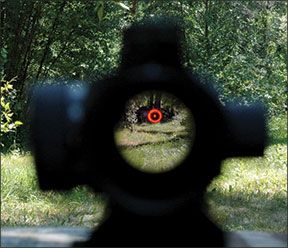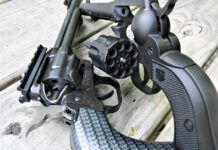In front of us this month are three of the black rifles, AR-15s by Rock River Arms, ArmaLite, and Bushmaster. There are – or were – many types of this rifle available, and there are also many aftermarket accessories available. In addition to the three guns, we were provided with some clever accessories to try on them. These include triggers by Timney and Geissele, some alternative stocks by Magpul, some iron-type sights by the same company, a very fine 20-round magazine that we used in all our testing, and one of the rapid-fire Slide-Fire stocks. We will give a detailed report on these rifles using some of these accessories in a separate later report. For this report, we take a look at the rifles pretty much as they came to us.

The specific guns were the Rock River Arms LAR-15 Tactical CAR A4 AR1201X ($1065), ArmaLite M15A4 Carbine No. 15A4CBA2K ($1031), and the Bushmaster Carbon 15 SuperLight ORC No. 90689 ($845), all in caliber 5.56 NATO. None had a top handle. All had the numbered-notch Picatinny rail. The Rock River and ArmaLite had front sights, but no rear. The Bushmaster Carbon 15 had no sights whatsoever, but came with a Chinese-made electronic red-dot sight. All three had the collapsible M4-type stock, and all three had 1:9-inch twist, 16-inch barrels.
We decided to first shoot all three rifles with a 36x Weaver CT36 Micro-Trac target scope with central dot, and then see if each rifle needed, say, a better trigger or a tighter stock. The Weaver scope was mounted in a proprietary base that was adapted to Picatinny rails and secured by two hefty screws to which we could put adequate torque. We shot the rifles at 100 yards using just two types of ammo. This was Black Hills 68-grain Heavy Match HP, and Russian TCW ball (55-grain FMJ) ammo, representing some of the finest and some of the least costly 5.56 ammo (formerly) available for these rifles. All other types of 5.56 or 223 ammo would, we thought, fall between these two extremes. Some might be better and some worse, but with todays limited supplies, we thought these two ammo types would give a good look at what you can expect from these three rifles. Along the way, we found good reasons to try one of the replacement triggers, and were glad to have had it on hand. Heres what we found on the rifles.
Rock River Arms LAR-15 Tactical CAR A4 AR1201X 5.56 NATO, $1065
The most costly of the trio was the Rock River. It was also the only one that didnt have a loose forend. Its barrel was also the largest in diameter at 0.740 inch, and it had the best trigger pull at 5.3 pounds. We could see no pressing need to change out the trigger on this rifle. The workmanship was generally excellent, and we could not really find any fault with the rifle. We wanted to install the Magpul UBR stock ($265), but it required a wrench we had to special order, so we didnt do it for this report. With that stock on the rifle, nothing rattles in the butt area. The finish of the Rock River LAR-15, as on all three rifles, was excellent, with uniform flat-black color everywhere. The Rock River had the most comfortable grip, made of rubber (Ergogrips.net). Hogue grips are optional, and in fact you can pretty much tell Rock River what specifics you want on your rifle and have it built to your specifications. Of course, you pay as you go, and your dealer has to order it.
We first opened the rifles, all three, and cleaned the bores briefly. That gave us a chance to look at the innards, and frankly, we could see little or no differences. All were well made, all had very similar parts, and as we found, they all worked about equally well. In short, nothing bad stood out. For those unfamiliar with the AR-15 (both of you), takedown is simplicity personified. Be sure the gun is clear, close the bolt, and press on the rear action pin with your fingernail or a bullet tip. Pull the pin to the right as far as you can (it stays in the action), and the upper part of the gun hinges open. If you want to remove the upper from the lower, pull the hinge pin in the same manner. The bolt can be withdrawn with the cocking lever, giving access to the barrel to clean it from the rear. On reassembly, be sure the hammer is cocked, and thats about it. The same technique applies to every AR-15 or clone thereof weve seen, but were sure there are a few oddballs. Read the manual!
We sighted in the 36x scope and then shot 3-round groups at 100 yards from a machine rest. We used the Magpul PMAG 20 magazine for all our testing with all three rifles. That magazine comes with a clip-on top cover that seals the fully loaded magazine from dirt, so we thought it would be an excellent way to carry a loaded magazine (or a bunch of them) and keep your ammo clean.
On the range the Rock River did quite well, though not as well as wed hoped. It put the match ammo into 1.7-inch groups on average. There were a couple failures to feed the top round off the Magpul magazine, but that problem went away quickly. They were traced to slight stickiness in the new magazine and our failure to seat the round properly. But it never happened with the other two rifles. The groups with the low-cost Russian ammo went as large as 5.1 inches, with an average of 4.5. However, on many of our three-shot groups two of the shots were extremely close to each other, nearly touching, in fact. The fliers made this the least accurate rifle with the Russian ammo.
There were no problems with firing or ejection. Once or twice we would have liked a lighter trigger, and we will be sure to try one in our next report on the accessories. But we could easily live with this one.
Our Team Said: We thought the Rock River LAR-15 was well made of good-quality parts. It shot well enough, though we had expected more. We would prefer to have a rear sight on any of these rifles that have a front sight, and if we owned this one wed either buy a top handle for it or fit one of the excellent Magpul add-on units tested in a separate report. This was an A-minus rifle, we thought, the minus for the somewhat poor accuracy with Russian ammo and the lack of tack-driving accuracy with the match ammo in that heavy barrel.
ArmaLite M15A4 Carbine No. 15A4CBA2K 5.56 NATO, $1031
This rifle looked a whole lot like the Rock River, but with a slightly smaller (0.720-inch) barrel, measured midway on the exposed portion. The forend was a bit longer than the Rock Rivers and, like the butt stock, it rattled. Like all three of these rifles, it had the forward-assist button, and we dont quite know why. In case of a malfunction or partial feed of a fresh round, the best way weve found to quickly and positively clear it is to withdraw the bolt, not try to jam it forward. Weve found that jamming the bolt forward generally succeeds only in making it harder to get the offending round out of the gun, because the bad round just about never goes fully home, cant be fired, and has to be pulled out the back manually. But to each his own.
Like all three rifles this one had the spring-loaded door on the ejection port. That brings up a peeve of ours. If you lock the bolt back and then close the door, which is sometimes a logical thing to do – as in windy, dusty conditions – there is no easy way to open that door to show the range master the bolts locked back. The only way to open the door is to cycle the bolt, which sometimes you may not want to do, for a variety of reasons. Weve had that complaint about each and all of these rifles weve examined and tested over the years. Wed like to see an easy-open system for that door. Are we alone?
On the range this rifle gave us the smallest group weve seen in a long time, three shots into 0.3 inch at 100 yards. The ArmaLite M-15 averaged just under an inch with all the groups fired with the target ammo. The Russian stuff was not bad either, averaging 2.5 inches. So, despite its 7.4-pound (consistent) trigger pull, it shot the best of the three rifles. We plan to put the Timney trigger into this rifle and try the Magpul stock in a later report, but the bottom line is it shot extremely well as it came to us.
Our Team Said: In light of its accuracy, we gave the ArmaLite an A. We would have liked it better if it weighed less, and we might have preferred the fancy Magpul stock, and we wanted a better trigger. But this setup worked pretty well as it was, we thought.
Bushmaster Carbon 15 SuperLight ORC No. 90689 5.56 NATO, $845
We thought this light rifle was the only one of these three that weighed the appropriate amount for the cartridge. That was a little over 5 pounds, plenty enough for the 5.56 NATO with all its manly horsepower. We could easily hold, and most likely shoot, the Carbon 15 with one hand.

The Bushmaster Carbon 15 had no sights at all, but came with a Chinese-made 1X30ST one-power, red-dot-&-circle scope. For this report, however, we took off the red-dot scope and stuck on our 36X Weaver. During our sighting-in, we had fits with the trigger on this rifle. The trigger broke at more than 7 pounds, and its pull varied all over the place. Accordingly, we installed a Geissele SSA-E Enhanced trigger. While the stock trigger would have been useable from our bench rest, we dont think this excellent replacement trigger was in any way cheating, because as we found, the rifle was still somewhat lacking.
The result of our changing out the Bushmasters trigger gave us a lovely, repeatable 3.7-pound pull, as crisp and nice as anyone would want. The cost of that trigger is $230, which might make you think hard about it, but the results are exactly what we were looking for in this rifle.
The question of the receiver material is foremost in many readers minds. We dont generally drive trucks over our guns to test them. One of our staff just bought his first Glock, which has a receiver made of a similar material to that of which the Carbon 15 is made. While we cant speak of the durability of the Carbon 15 in warlike conditions, we would never personally take any rifle of this type and of this cartridge into a war zone. More to the point, we believe if you take care of any gun, it will last, and will serve you. We dont think you ought to try to break your guns to test them. As noted above, we feel the Carbon 15 is the only one of this trio that has the proper weight for this cartridge. The other two are way too heavy. The Carbon 15 receiver is apparently not made of carbon fiber, the stuff of Formula One racing cars, Ducati motorcycles, and racing bicycles, but it seems to be plenty strong enough for any normal use to which one might put the AR-15. Until one breaks in our hands, thats our general belief about the Carbon 15. It works, is plenty strong enough for the job at hand, and its light weight is indeed a blessing.
The workmanship here was on a par with the other two rifles. The rifle comes with chrome-lined bore and chamber, for which some makers charge more. One difference was the butt stock was smaller (and lighter) than the other two, which was only a bother for us on the machine rest, but not for normal shooting. The barrel here was the slimmest at 0.594 inch. By the way, all three rifles had what appeared to be the identical flash hider. This rifle did have the forward assist, which, as we found on the Internet, some guys demand, for whatever reason.
On the range at 100 yards we found the Bushmaster Carbon 15 made groups with the match ammo of 2.6 inches. With the Russian ammo, groups were just an inch larger at 3.6 inches. Thats better than the Rock River did, but not quite as good as the ArmaLite did with the Russian fodder. Is that enough accuracy? We think it is, unless formal target shooting is your goal.
We found the red-dot 1X scope sight to be dubious. It depends on a battery, which is prone to being left on so the battery can die. The glowing red dot-within-a-circle was way too bright outdoors on even the lowest setting, and we had a hard time seeing much of anything through the scope, even with the bright reticle turned off. The zeroing adjustments on the scope were quite good, and that 1X scope might be ideal in low-light situations, but we were not at all happy with it, overall. Well look harder at it in our later report on accessories. So youre getting a gun with a sight that we did not like at all for normal daylight situations, and we think many of you would also not like it. We thought a low-cost, small, and sturdy 1.5X to 4X fixed-power hunting scope, or a set of add-on iron sights, would be far better for daylight use than the electric optic that comes with the Carbon 15. And there are also other options of the Bushmaster Carbon 15 that might make a better package for you.
Our Team Said: We liked the feel of this rifle the best, but had to downgrade it for its unusable trigger pull and lack of a decent sight. We gave it a B rating because of those. We thought it had enough accuracy, though not for competition target work. You can drop in a replacement trigger like we did, but an honest gunsmith can probably redo your standard trigger for a lot less than the cost of the unit we stuck in there. Other than that, we thought this was the best setup of the three for size and weight.
Written and photographed by Ray Ordorica, using evaluations from Gun Tests team testers. GT






























